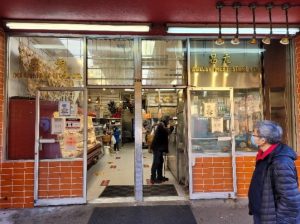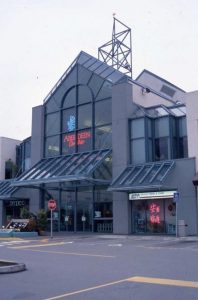“That’s Not Real Chinese Food:” Exploring the Evolution of
Chinese Canadian Cuisine in the past 55 years
by Justin Wong
Maggie Ip has seen incredible changes in Chinese Canadian food since arriving in Ottawa in 1966. At the time, Canada’s population was under 20 million and the country had just adopted the Maple Leaf flag a year before. Chinese Canadians were also rare as the Chinese Exclusion Act was only repealed in 1947. “Back then, I was told there were roughly 1000 Chinese in Ottawa. 1/3 were students, 1/3 were scientists at the National Research Council, and 1/3 were Lo Wah Kiu (old Chinese-Canadians),” Maggie recalls.
Although there were several Chinese restaurants in Ottawa, they were quite different from what was served in the motherland. “I remember one restaurant that just opened serving ho fun (dried noodles). We were very excited to try it but became disappointed only to discover that they did not use authentic
ingredients. Better than nothing though.” One Ottawan recalled that “as a young boy, my first reaction to our restaurant’s food was to be disappointed [sic] that it wasn’t as tasty as my mother’s — authentic — home cooking” (Ottawa Citizen, 2020). Ann Hui, author of Chop Suey Nation, remarked that the Chinese Canadian dishes of that generation were “made with local ingredients, made with local palates in mind, [and] made here in Canada” (ibid).
A glance at the menu of Canton Inn shows what one might have encountered at a typical Chinese restaurant at the time. There is no Chinese on the menu, the dishes feature ingredients foreign to China (pineapple, sweet & sour) and are synonymous with Lo Wah Kiu cuisine (soo guy, egg foo young, chop suey).
To satisfy her craving for authentic Chinese food, Maggie had to look beyond Ottawa. “At the time, you couldn’t buy tofu — a staple in Chinese cuisine. So, we would have to drive to the Chinatown in Montreal for that as well as for BBQ pork, spices, and other Chinese ingredients.” The Montreal Gazette (1964) noted that Chinatown had “wonderfully-exotic Oriental ingredients that can be obtained nowhere else”.
Maggie remembers that sauces, dried food, spices, and other non-perishables were all imported from China. But that one could buy bok choy from Chinese Canadian farmers. However, there were already several food companies supplying perishable domestic-made Chinese-style food to families and
restaurants. Wong Wing and Sunrise Soy Foods are two examples that still survive today.
In Elizabeth Zanoni’s, Migrant Marketplaces, she writes that Italian food imports were highly sought after by both the Immigrants and Anglo-Americans for their superior quality and taste (Zanoni 2018, 75). In contrast, Maggie recalls that Chinese imports were low quality and cheaper than domestic alternatives. Moreover, Italian-originated products directly competed with tipo Italiano foods, such as fruits, vegetables, and meat such as tomatoes, beef, and pork (Zanoni 2018, 76). But Maggie says that Chinese fruits and vegetables were grown locally given the long shipping times across the Pacific Ocean. While tipo Italiano appealed to Italian migrant consumers (Zanoni 2018, 96), Chinese Canadian food companies catered to the growing demand of Chinese as well as to non-Chinese. Not only were domestically produced Chinese food better quality than China’s, but Chinese food was one of the most popular ethnic cuisines in North America at the time.
A combination of the riots in Hong Kong and the change to the points system helped accelerate Chinese immigration to Canada in 1967. According to Maggie, this new wave of immigrants from Hong Kong was well-educated, wealthy, and demanded authentic Chinese food. A few years later in 1970, Maggie moved from Ottawa to Vancouver, following her husband’s job transfer. “I remember in 1972, Hon’s (won-ton shop) opened up,” she said. They cooked the won-ton in front so you could see it being made, just like in Hong Kong.” One block west, a dim-sum restaurant called Asia Garden, opened the same year. “On Sundays, [our family] would go down to Chinatown. We would first stop by Asia Garden for dim-sum, then go to the stores nearby for meat, vegetables, and herbs” Maggie recalls. James Barber (1971), a Canadian
cookbook author, wrote that Asia Garden was “case close as you can get to total immersion in another culture, a real Hong Kong Style lunch, surrounded by hundreds of Chinese families (…), totally different to any other Chinese food you have ever tasted.” “[Nonetheless], the ‘old’ Chinese restaurants still existed. For example, On On Tea Garden — it was small but popular because Pierre Trudeau liked the food there”.
Maggie shopping for vegetables in
Chinatown. Photo: Justin Wong
The years following the Sino-British Joint Declaration of 1984 saw a new wave of Hong Kongers moving to Canada. It was estimated that one out of two Hong
Kongers in B.C. would eventually end up in Richmond (Jang, 1991), although areas around Vancouver too started becoming populated with Chinese and their businesses and restaurants. “Now people started asking themselves, why drive to Chinatown when I can get everything I need in my neighbourhood?” In 1989, Aberdeen Centre, the first Asian mall in North America opened its doors in Richmond. One newspaper described the mall as the place where “the bowlers speak Cantonese, [and] the menu features shark-fin soup” which “mostly cater to Hong Kong tastes” (The Windsor Star, 1991).

Kelly (husband of Maggie) standing in front of Dollar Meat
Store, one of the last surviving shops in Chinatown from the
1970s. Photo: Justin Wong
Now, immigration from other parts of China has diversified Chinese cuisine (no longer just Cantonese). “You can find food from every corner in China and in all varieties; Sichuan to Xinjiang, takeout to Quanjude (high-end Peking duck), hotpot to cold noodles” asserts Maggie. The Vancouver Sun (Cernetig, 2007) even claimed that the city had the best Chinese food in the world given the abundance of seafood and high-level chefs. Lamentably, the once-dominant Canton Inn-esque restaurants of yesteryear can no longer be found in Vancouver. However, there are plans to reopen an old-style Chinese eatery
this year in Chinatown. The story of Chinese Canadian cuisine is just as much a story of immigration as it is about changing tastes — if not even more so. When asked if Maggie’s preference for Chinese food has changed over the years, she shook her head. “You can never force me to eat Mala (numbing and spicy seasoning) for as long as I live,” alluding to the increasingly popular Sichuan cuisine is increasingly popular in Vancouver.
Aberdeen Centre in 1992. Photo: City
of Richmond.
Mural from the Seat at the Table Exhibit
in Chinatown. Photo: Justin Wong
Bibliography
“About Sunrise Soya Foods: Canadian Soy & Tofu Products.” Sunrise Soya Foods. Accessed February 17, 2022.
“About Us.” Wing’s Food Products, September 23, 2021.
“B.C. Success Story: Sunrise Soya Foods Wins Canada’s Best New Dessert Award for Super Squeezies.”
Yahoo! Finance. Yahoo!, June 27, 2013.
Cernetig, Miro. “June 30, 2007 (Page 6 of 128).” 2007. The Vancouver Sun (1986-2016), Jun 30, 6.
Barber, James. “December 31, 1971 (Page 56 of 93).” 1971. The Province (1956-2010), Dec 31, 56.
“Good Fortunes.” Industry Today, November 5, 2021.
“History.” Wing Noodles Ltd. Accessed February 17, 2022.
Hum, Peter. “Defining ‘Authentic’ Chinese Cuisine.” ottawacitizen. Ottawa Citizen, August 21, 2019.
Hum, Peter. “The Popularity of Ottawa’s Chinese Food Is at an Apex – and Options Have Never Been More Diverse.” ottawacitizen. Ottawa Citizen, January 27, 2020.
It’s not your average shopping mall: [FINAL edition]. (1991, Mar 11). The Windsor Star.
Jang, Brent. 1991. “Hong Kong Goes to Richmond: B.C. City’s Lower Taxes, Costs Attract Entrepreneurs: [City Edition].” Kitchener – Waterloo Record, Mar 19, B5.
“June 27, 1964 (Page 37 of 65).” 1964. The Gazette (1867-2010), Jun 27, 37.
“Montréal Signs Project.” Wong Wing Foods. Accessed February 17, 2022.
“Our Story.” Wong Wing. Accessed February 17, 2022.
Robinson, Kristen. “Iconic Ho Ho Restaurant Set to Reopen in Vancouver’s Chinatown Early next Year – BC.” Global News. Global News, August 10, 2021.
Stainsby, Mia. “History of Vancouver Restaurants, a Chronology and Memories.” vancouversun. Vancouver Sun, April 13, 2011.
Stainsby, Mia. “History of Vancouver Restaurants, a Chronology and Memories.” vancouversun. Vancouver Sun, April 13, 2011.
Zanoni, Elizabeth. Migrant Marketplaces: Food and Italians in North and South America. Urbana: University of Illinois Press, 2018.



